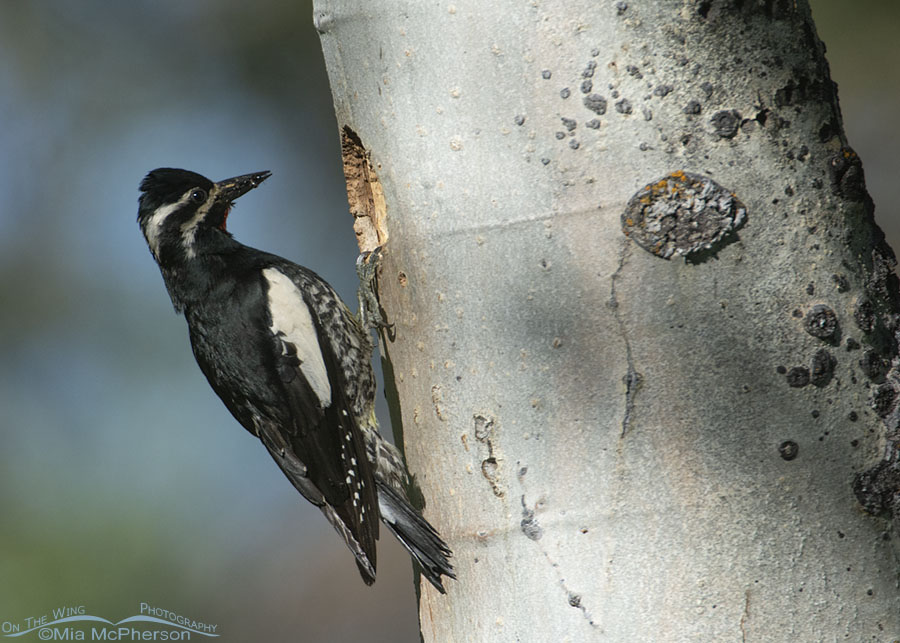 Male Williamson’s Sapsucker with food in his bill for his chicks – Nikon D7100, f6.3, 1/2000, ISO 640, +0.7 EV, Nikkor 200-400mm VR with 1.4x TC at 357mm, natural light
Male Williamson’s Sapsucker with food in his bill for his chicks – Nikon D7100, f6.3, 1/2000, ISO 640, +0.7 EV, Nikkor 200-400mm VR with 1.4x TC at 357mm, natural light
For one and a half wonderful nesting seasons I was thrilled to photograph a pair of mated Williamson’s Sapsuckers excavating a nest and tending to their young.
If I hadn’t heard and spotted a pair of House Wrens nesting in that same aspen at the end of May I may never have seen these gorgeous sapsuckers. After I found the wrens in that aspen and started photographing them the sapsuckers showed up and it was obvious that they were busy excavating a nesting cavity above where the wrens were bringing nesting materials to the cavity they were nesting in.
Paying attention to the sounds and sights of this alpine forest paid off nicely because by the 1st of July these Williamson’s Sapsuckers had chicks in the nest. I knew that because the adults were bringing in food to the nesting cavity and I could hear the chicks inside the tree begging to be fed.
Williamson’s Sapsuckers are a secretive species of the Intermountain West and breed in coniferous forests. They have specific habitat needs because of their dependence on sap and phloem. Williamson’s Sapsuckers eat ants that crawl up trees and they also suck sap from the wells they drill in the trees.
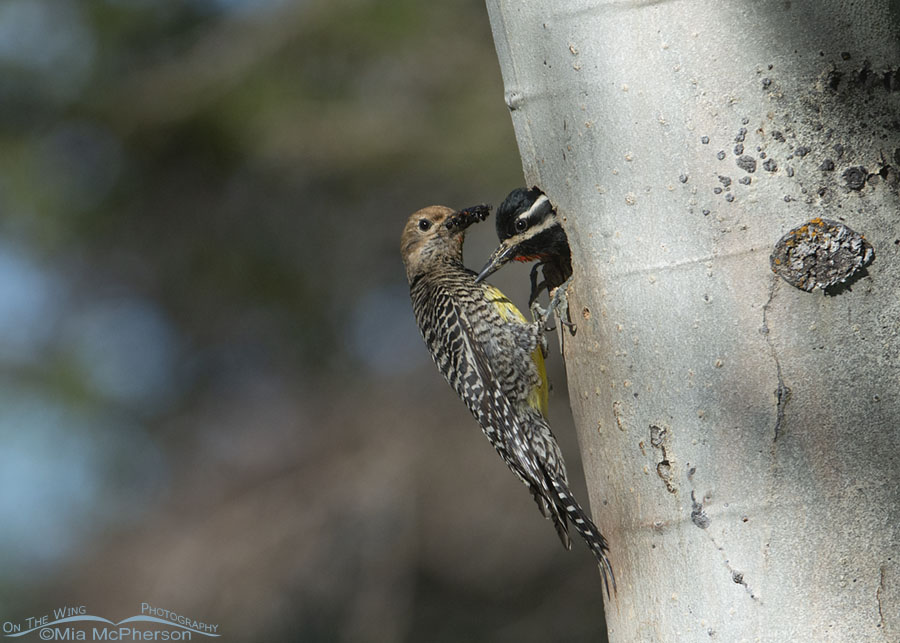 Female and male Williamson’s Sapsuckers together at their nest – Nikon D7100, f7.1, 1/1600, ISO 640, +0.7 EV, Nikkor 200-400mm VR with 1.4x TC at 257mm, natural light
Female and male Williamson’s Sapsuckers together at their nest – Nikon D7100, f7.1, 1/1600, ISO 640, +0.7 EV, Nikkor 200-400mm VR with 1.4x TC at 257mm, natural light
Williamson’s Sapsuckers are sexually dimorphic which means that the sexes exhibit different characteristics beyond the differences in their sexual organs. Female Williamson’s Sapsuckers were thought to be a different species for a period of time because they appeared to be so different than the males.
A little ornithological history about this species:
John Cassin, a noted ornithologist and taxonomist first described this species as Picus thyroideus in 1851 from two female specimens collected by John G. Bell in California and by 1856 the common name was Black-breasted Woodpecker.
In 1855 John Strong Newberry collected the first male specimen in southern Oregon and named it Williamson’s Woodpecker. Spencer Fullerton Baird renamed the genus Sphyrapicus in 1857. Two other common names during this time period were Baird’s Brown-headed Woodpecker and Cooper’s Round-headed Woodpecker.
In 1873 Henry Wetherbee Henshaw ended the confusion between the two “species” when he observed a mated pair at a nest in Colorado and verified that the two were a single species.
By 1886 the name sapsucker was applied in the first checklist of American Ornithologists’ Union and the common name Williamson was recorded. This species was named after Robert Strong Williamson who was with the expedition with John Strong Newberry when the first male specimen was collected.
What a joy is must have been for early naturalists and ornithologists to explore this country to find, document and name new birds.
Back to the meat of this post though, the fun I had photographing these nesting Williamson’s Sapsuckers.
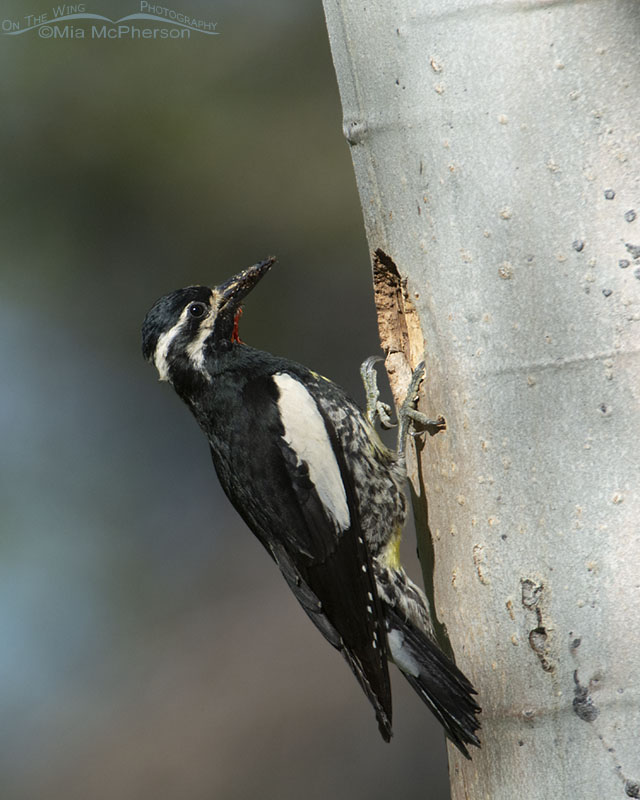 Williamson’s Sapsucker male checking out his nest cavity – Nikon D7100, f7.1, 1/1600, ISO 640, +0.7 EV, Nikkor 200-400mm VR with 1.4x TC at 400mm, natural light
Williamson’s Sapsucker male checking out his nest cavity – Nikon D7100, f7.1, 1/1600, ISO 640, +0.7 EV, Nikkor 200-400mm VR with 1.4x TC at 400mm, natural light
The pair of Williamson’s Sapsucker flew in and out the the nesting cavity frequently. Bringing in food, mostly ants, for their chicks required them to forage for prey and bring it back in to the nesting cavity regularly. This species seems to land on trees near the nesting cavity where they stop and look around. I’m guessing they do that so they can look for predators in the area before they go to the actual nest.
Fortunately for me as a bird photographer they usually call before they fly in so I was able to pinpoint their location at the edge of the forest as they flew in to the nesting cavity.
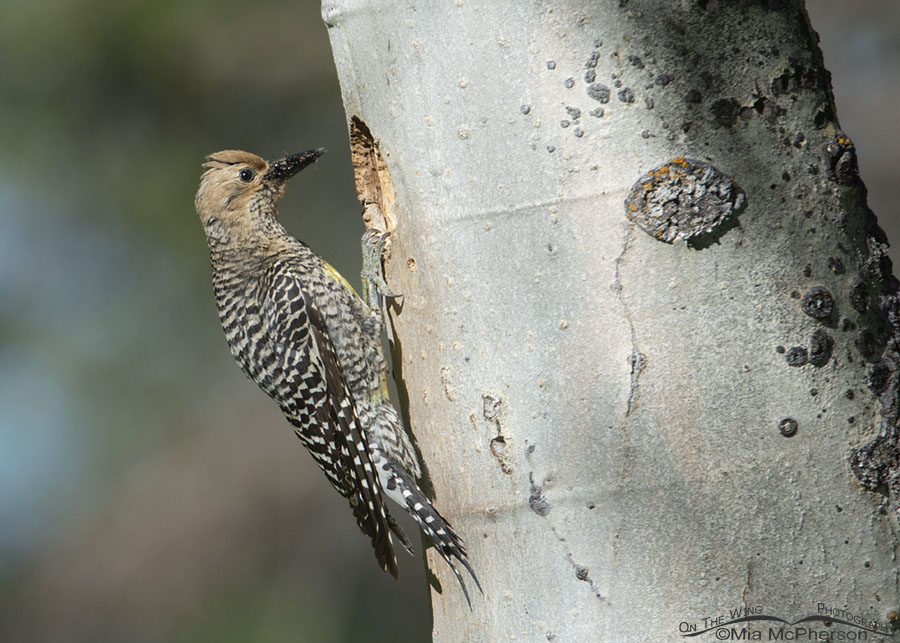 Williamson’s Sapsucker female with food in her bill for her chicks – Nikon D7100, f7.1, 1/1250, ISO 640, +0.7 EV, Nikkor 200-400mm VR with 1.4x TC at 314mm, natural light
Williamson’s Sapsucker female with food in her bill for her chicks – Nikon D7100, f7.1, 1/1250, ISO 640, +0.7 EV, Nikkor 200-400mm VR with 1.4x TC at 314mm, natural light
I usually had the best light on the aspen a few hours after the sun came up, prior to that the mountains to the east and the nearby trees shadowed the entrance to the nest and the aspen tree it was in. Trying to photograph the sapsuckers flying in was extremely challenging.
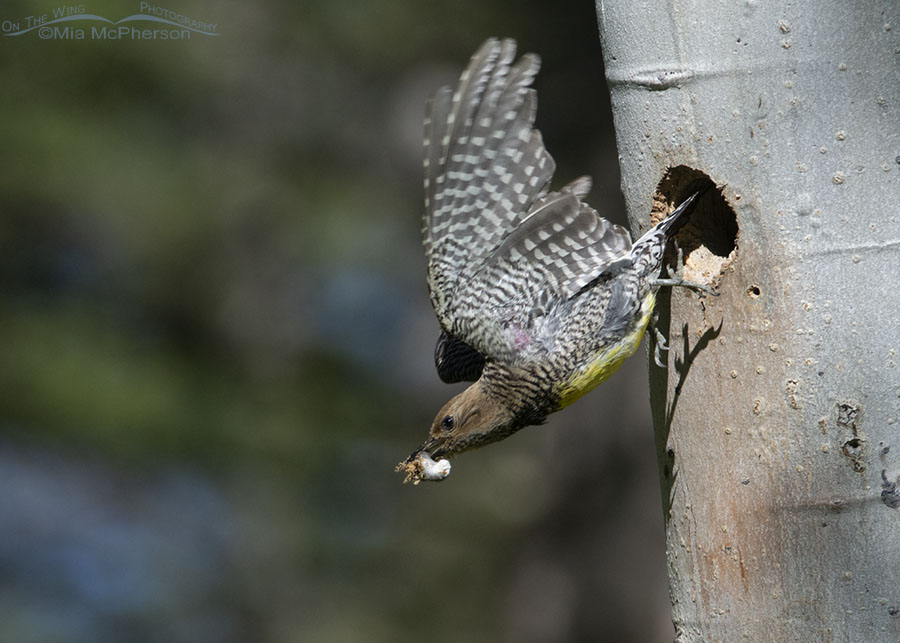 Female Williamson’s Sapsucker flying away with a fecal sac – Nikon D7100, f7.1, 1/2000, ISO 640, +1.0 EV, Nikkor 200-400mm VR with 1.4x TC at 221mm, natural light
Female Williamson’s Sapsucker flying away with a fecal sac – Nikon D7100, f7.1, 1/2000, ISO 640, +1.0 EV, Nikkor 200-400mm VR with 1.4x TC at 221mm, natural light
I did better when they were flying away from the nesting cavity but even that was difficult because they take off so fast. The sapsucker adults parenting duties includes removing the fecal sacs of the young to keep their nest tidy and clean. In this photo the white fecal sac that the female Williamson’s Sapsucker is flying away with is obvious.
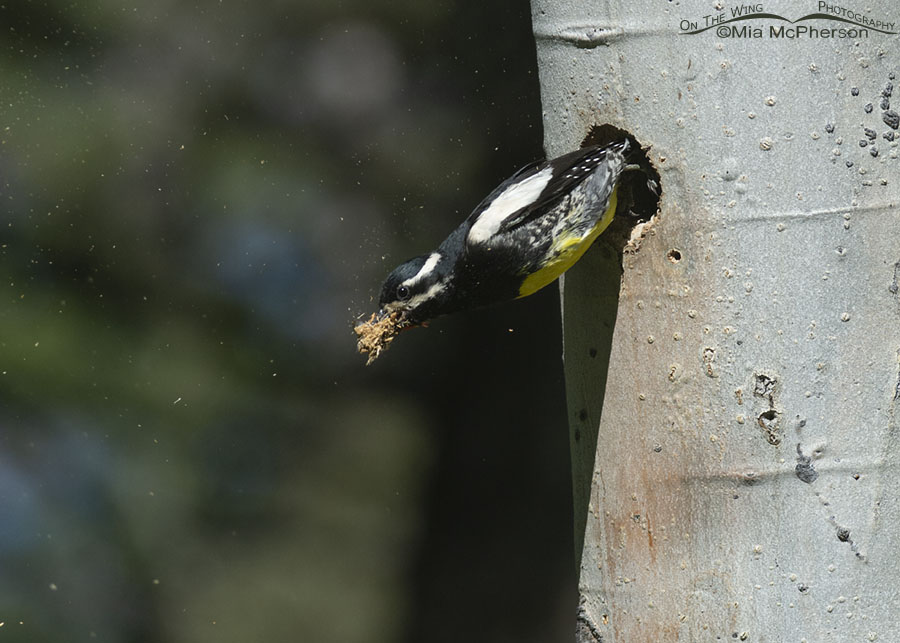 Male Williamson’s Sapsucker taking off with sawdust covered fecal sac – Nikon D7100, f7.1, 1/2500, ISO 640, +0.7 EV, Nikkor 200-400mm VR with 1.4x TC at 200mm, natural light
Male Williamson’s Sapsucker taking off with sawdust covered fecal sac – Nikon D7100, f7.1, 1/2500, ISO 640, +0.7 EV, Nikkor 200-400mm VR with 1.4x TC at 200mm, natural light
In this photo of the male taking off with a fecal sac it isn’t quite as obvious because of the sawdust that covered it.
In some bird species the males have nothing at all to do with rearing the young but Williamson’s Sapsucker males help with incubation and raising their chicks.
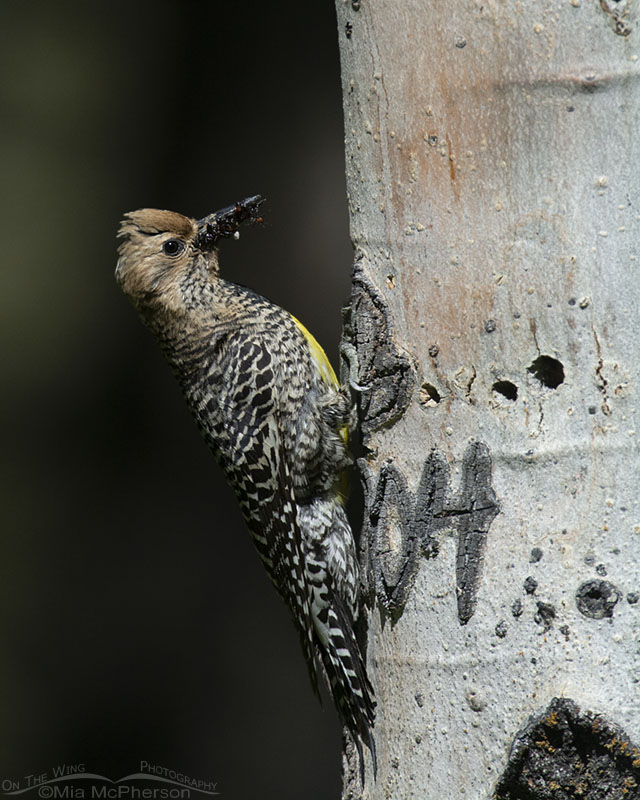 Female Williamson’s Sapsucker with a bill full of prey for her chicks – Nikon D7100, f7.1, 1/2500, ISO 640, +0.7 EV, Nikkor 200-400mm VR with 1.4x TC at 350mm, natural light
Female Williamson’s Sapsucker with a bill full of prey for her chicks – Nikon D7100, f7.1, 1/2500, ISO 640, +0.7 EV, Nikkor 200-400mm VR with 1.4x TC at 350mm, natural light
Photographing this pair of Williamson’s Sapsuckers was a joy I hope to never forget but as long as I have my site up and running I have the stories and facts behind the photos of all the birds I have written about at my fingertips.
I never did see the young sapsuckers poke their heads out of the nesting cavity because I had to leave and head back to Utah. I really wish I had been able to photograph their chicks as they fledged.
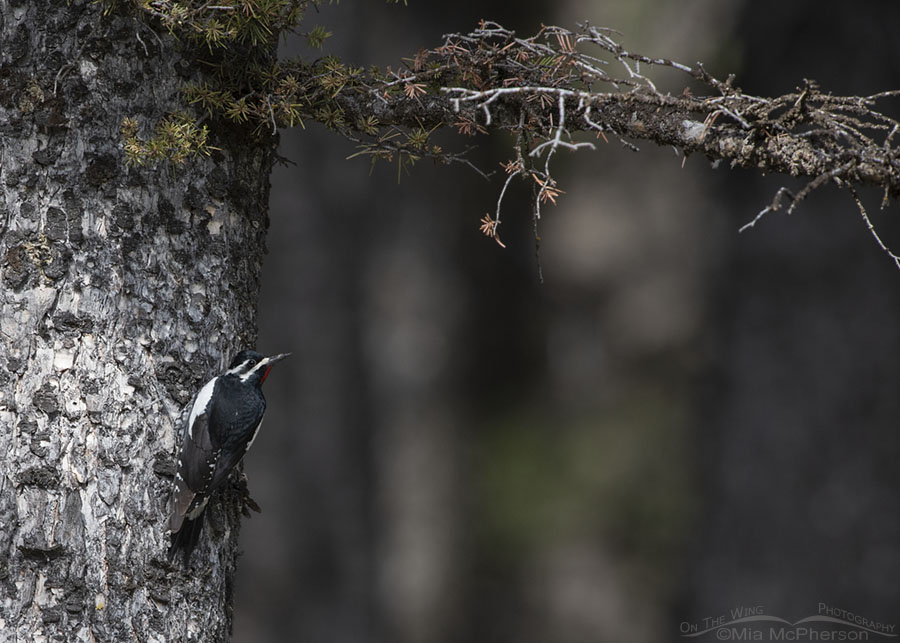 Male Williamson’s Sapsucker clinging to an ancient conifer – Nikon D810, f7.1, 1/640, ISO 540, -0.3 EV, Nikkor 500mm VR with 1.4x TC, natural light
Male Williamson’s Sapsucker clinging to an ancient conifer – Nikon D810, f7.1, 1/640, ISO 540, -0.3 EV, Nikkor 500mm VR with 1.4x TC, natural light
The Williamson’s Sapsuckers challenged me as a bird photographer but it was worth it to see, observe, photograph, and learn about this species of sapsuckers.
I know that if I ever find another breeding pair of Williamson’s Sapsuckers that I can apply all the knowledge I learned about them and overcome any of the challenges that I might meet.
Life is good. Stay safe.
Mia
Click here to see more of my Williamson’s Sapsucker photos plus facts and information about this species.


Absolutely fascinating series of nesting Sapsucker pics and your narrative is wonderful. Thanks Mia.
I’ve missed all the information that has gone along with these wonderful images…
A wonderful, WONDERFUL SERIES.!!! A FEAST…THANK YOU….
I envy you your time spent with these dedicated parents. Thank you for bringing us along! 🙂
Beautiful photos! I found a corresponding YouTube video: https://m.youtube.com/watch?v=9kwuBe3Z6sY.
WHAT a wonderful series.
Your memory banks are rich – even without the additional bonus of photos.
Excellent series of photos and very interesting description! I don’t think I’ve ever seen a Williamson Sapsucker before.
Interesting history along with wonderful photos.
Wow, the female Williamson’s Sapsucker really is different than the male. Softer colours & to my mind, almost prettier.
That yellow belly is striking. I will not forget the first one I saw at my water feature in our New Mexico yard.
Wonderful pictures, Mia!